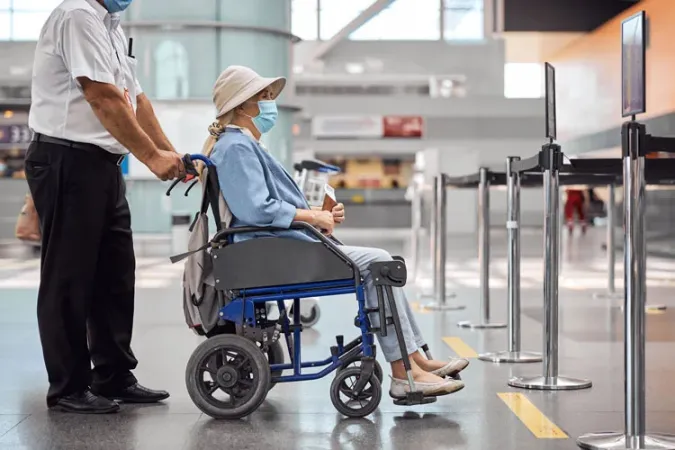
Can You Take a Wheelchair on a Plane?
People with disabilities are allowed to fly on airplanes, and airlines are required to do so free of charge. Before booking your flight, contact the airport or airlines to speak with someone who can give you the details of their specific accessibility policy. Also, remember to have the model and make of your wheelchair available so they can provide you with supporting details to board the plane.
Airlines do their best to accommodate the needs of all their passengers; however, with so many people on one flight at a time, having various medical, mental, and other conditions can pose a challenge to even the largest companies in the industry. One of those challenges specifically is when it comes to wheelchair accessibility on readily available commercial flights.
Using a Wheelchair in Your Daily Life
If you’re someone who uses a wheelchair as an integral part of your daily routine and is interested in flying, the good news is that most airlines allow you to bring your wheelchair onboard. However, before you take your wheelchair on a plane, you need to speak with the specific airline’s support team you’ve booked a ticket with to get the details about their wheelchair policy.
There are also some other important variables that you need to consider prior to bringing your wheelchair aboard your flight. Below, we’re going to give you all of the critical information you need to know about flying with a wheelchair to explore the world freely.
Manual Wheelchair vs Power Wheelchair
Manual Wheelchair
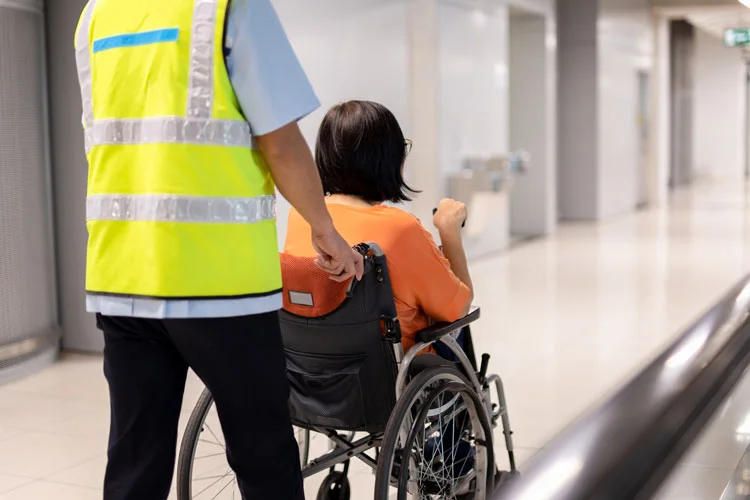
The Air Carrier Access Act mandates that airlines provide a place to store a collapsible, folding or break-down manual wheelchair in the aircraft cabin. All airplanes with 100 seats or more for both international flights or domestic flights must have a wheelchair closet measuring at least 13 inches by 36 inches by 42 inches.
If your manual wheelchair has a rigid frame and will not fit inside the onboard wheelchair closet, the wheelchair will need to be stored in the airplane cargo hold.
When storing a wheelchair in the cargo compartment, it is recommended that all detachable parts of the wheelchair be removed and stored in the aircraft cabin.
Such components may include seat cushions, side guards, footrests, cup holders, bags, lighting kits and other attachments. These items may be stored at your seat, in an overhead bin or in the wheelchair closet.
If an airline has chosen not to install the wheelchair closet required by the ACAA, it must secure manual wheelchairs in the aircraft cabin using the seat-strapping method.
The seat-strapping method is a way of tying down a folding wheelchair to a row of seats on the airplane. Seat-strapping is permitted and allows carriers to forgo the installation of the large wheelchair closet. However, when an airline makes this decision, it must accommodate a passenger’s wheelchair in the cabin by strapping it to a row of seats.
The airline is obligated to do this, even if the flight is fully booked. Passengers displaced as a result of their seats being used to secure a wheelchair are entitled to denied boarding compensation as outlined in 14 CFR Part 250.
As a result of these requirements, most carriers do provide the wheelchair closet onboard.
Power Wheelchair
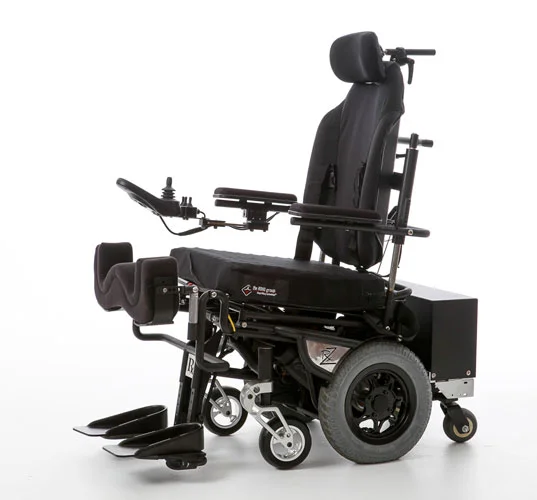
Power wheelchairs are not allowed in the passenger cabin of an airplane. Simply put, they are usually too heavy and wide to use in the cabin among the tight aisles.
When you are at the gate at the airport, you will be provided with an aisle manual chair to transfer into. The aisle chair will be your means of mobility onto the plane from the gate, to your seat, and for use on the plane such as using the restroom.
Your battery powered wheelchair will be taken and stowed in the cargo compartment of the plane. The U.S. Department of Transportation prohibits airlines from charging you an extra fee to stow your motorized wheelchair as they often do for checked luggage.
It can be helpful to the airline if you provide a copy of the power chair’s owner manual in case airline personnel need to drive or disassemble it. This helps ensure proper care of your motorized wheelchair, lithium-ion batteries, and any other chair components to help speed up the loading and unloading process.
Passengers who have disabilities can board the airplane before all other passengers, even those who have purchased priority boarding. An airline employee is required to assist you if requested. This is usually the case as most people who use power wheelchairs cannot push themselves in a manual wheelchair.
Once the plane has landed and is at the gate, flight attendants will allow you and anyone else with a disability will be allowed to disembark before other passengers.
Your power wheelchair will be returned to you as close to the plane’s door as possible, whether it be at the jet bridge or at the gate. It should be fully assembled and in the same condition as it was when you checked it before the flight.
It can be intimidating to fly with your powered wheelchair if you have never done it before, but people do it every single day. Don’t hold yourself back from enjoying a vacation or visiting loved ones.
How to Fly with a Wheelchair on an Airplane
Before you actually board your plane, you need to contact the airline and ask to verify your reservation in addition to inquiring about any special accessibility options or assistive devices available to you as a flyer. Frequently, airlines give you the ability to check-in to you flight eight via online, by way of an app, or in person.
Most airlines won’t allow you to bring your own wheelchair on board; however, you can leave it at the check-in, and the airport personnel or flight attendant will provide you with one that is suitable for flight. Airlines also recommend that wheelchair flyers arrive at least 2-3 hours before their scheduled flight to ensure they can clear security, make their way to their boarding spot, and check in their wheelchair and other equipment.
Here are a few helpful tips that you can use to ensure that your next flight with your wheelchair goes as smooth as possible:
- Consider how you will transition into your seat, you can either use a transfer board or transfer straps
- Book a seat in the aisle closest to the front of the plane
- Please take a picture of your wheelchair before boarding the flight so that you have proof of its condition in the event that you have to file a damage claim
- Try to book direct flights as soon as possible to reduce exiting and boarding the plane multiple times with multiple connecting flights
- Power wheelchair users need to have the model, type, and make of their chair available when speaking to the airlines
Wheelchair passengers are still required to wait with the other passengers once the plane lands until you will be allowed to exit. As you can see, air travel and flying on an airplane with a wheelchair isn’t a complicated process. As long as you follow all of the required steps during the booking, onboarding, and landing phase, you will be able to fly hassle-free.
Baggage Claim
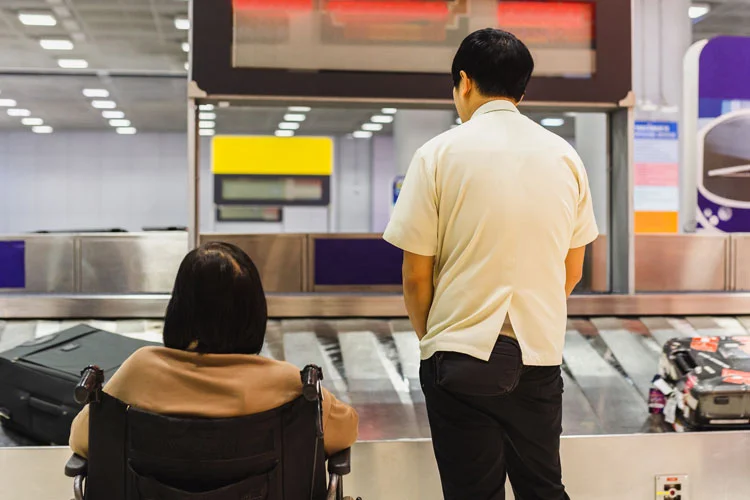
When providing assistance to passengers with disabilities who are navigating the airport, airlines are required to assist passengers in carrying their gate-checked or carry-on luggage when passengers are unable to carry the luggage due to their disability. This includes baggage claim.
One of the most preventable causes of mishandled or misdirected baggage is an improper baggage label. To avoid hassle and an unnecessary baggage fee, every passenger should inspect the baggage label when checking a bag to ensure that the flight numbers and destination listed match your itinerary.
Passengers checking baggage should also check-in at least 90 minutes prior to departure to ensure that baggage makes it onto your flight.
Another common reason for baggage delays are tight connections. The shorter your connection, the less time baggage handlers and ground crew will have to move your luggage from your inbound to your connecting flight. As a general rule, you should allow 90 minutes of connecting time to ensure your bag successfully changes flights with you.
If your bag is not at baggage claim when you arrive, report your airline’s baggage service office. These offices are traditionally located near the bank of baggage carousels utilized by your airline.
Locating your lost or delayed items is much easier if you have your claim receipt or boarding pass. Most airlines scan and track baggage throughout the transit journey, and information is often readily available. The staff will typically be able to pinpoint where the checked luggage was last scanned, and if it missed your flight.
Airline’s Complaint Resolution Official
If you encounter a disability-related issue related to an airline accommodation or service, you can request to speak with the airline’s Complaint Resolution Official (CRO) or a supervisor.
A CRO is the airline’s expert on disability-related issues in air travel and has the authority to resolve complaints on behalf of the airline. Every airline must have a CRO available either by telephone or in person during operating hours.
The Complaint Resolution Official (CRO) is responsible for resolving disability-related issues that have escalated beyond an initial interaction with airline personnel.
Each air carrier is required to have one or more designated CROs on-site or available by phone. This individual should thoroughly understand the Air Carrier Access Act (ACAA).
Each air carrier must have at least one Complaints Resolution Official (CRO) available at each airport during times of scheduled air carrier operations. The CRO can be made available by telephone.
Any passenger with a complaint of alleged violations of the Air Carrier Access Act (ACAA) rules is entitled to communicate with a CRO. The CRO has authority to resolve complaints on behalf of the air carrier. The CRO, however, does not have the authority to countermand a safety-based decision made by the pilot-in-command of an aircraft.
If the CRO agrees with the passenger that a violation of the rule occurred, the CRO must give the passenger a written statement summarizing the facts and what steps if any, the air carrier proposes to take in response to the violation.
If the CRO determines that no violation has occurred, the CRO must give the passenger a written statement summarizing the facts and reasons for the decision or conclusion.
If possible, the CRO’s written statement must be given to the passenger at the airport; otherwise, it will be sent to the passenger within 10 days of the incident.
If the passenger is not satisfied with the response, the passenger has the right to pursue an enforcement action with the U.S. Department of Transportation (DOT). If a passenger chooses to file a written complaint, the complaint should note whether the passenger contacted the CRO at the time of the alleged violation, and include the CRO’s name and the date of contact, if available. It should include any written response received from the CRO. Complaints should be mailed (postmarked) within 45 days after the date of an alleged violation.
A carrier must respond to a written complaint within 30 days after receiving it. The response must state the airline’s position on the alleged violation, and may also state whether and why no violation occurred, or what the airline plans to do about the problem.
Things to Remember
It would help if you still remembered contacting the airport you’re going to be departing from and arriving at to check and confirm their disability accessibility policies. Most airports and airlines clearly state their disability policies on their websites, making it easy for you to get the information you need without calling.
Another essential thing to remember is that if you have the option of choosing between connecting flight or a direct one, always choose the direct flight to cut down on the hassle.
Wheelchair Questions
Below is a list of some common questions we get about wheelchairs and how to deal with them on planes.
Do You Have to Pay to Take a Wheelchair on the Plane?
No, airlines are required to accept wheelchairs on their flights for free. If your wheelchair is not compatible with the particular plane you’re getting on; the airline will likely give you a wheelchair for free to use.
Can I Check in a Wheelchair on an Airplane?
Yes, you can check your wheelchair in as check-in baggage with most airlines. Depending on where you check it in at, it will be returned to a specific area when you get off the plane. If you turn your wheelchair in at the baggage claim, they will return it to the oversize baggage claim area. When you check the wheelchair in at the boarding gate, it will be returned to the jetway portal when the plane lands.
How Do I Fly with a Disability?
You can fly with a wheelchair with a disability in one of two ways; you can either bring your own wheelchair (but may need to bring spare parts along with you to avoid any issues) or fly utilizing airline provided mobility equipment (usually a manual wheelchair) .
Conclusion
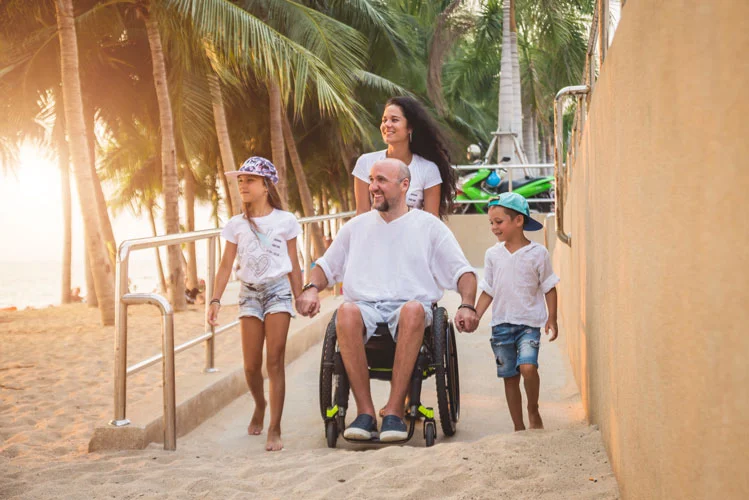
Use all of the information and tips we’ve included in this write-up to enjoy flying with your wheelchair conveniently. If you still have any questions, don’t forget to contact the airport and airlines you’ll be using to get the information you need.
Learn more tips and tricks on mobility in a wheelchair by continuing to explore our website. Have a great trip!
